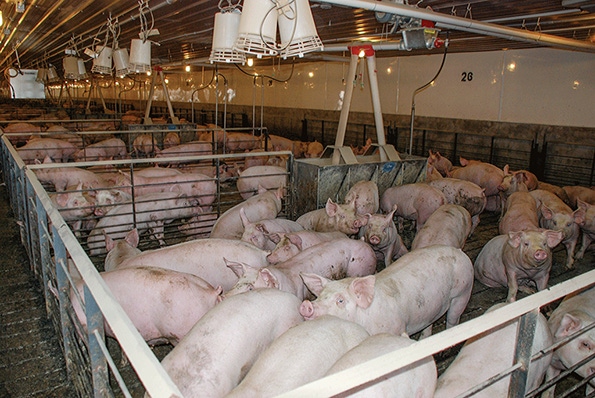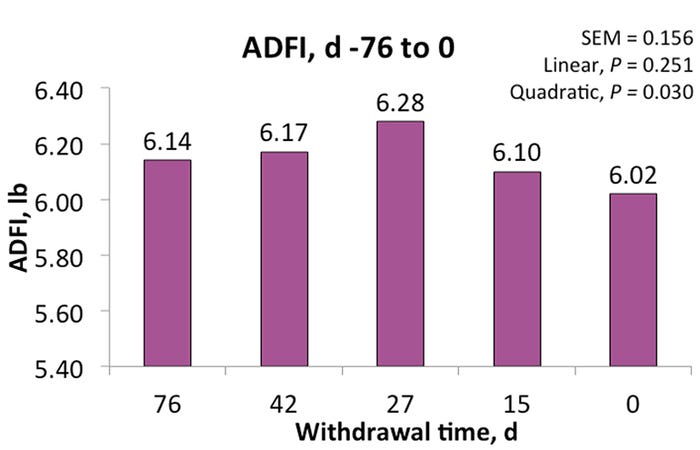DDGS withdrawal improves pig growth rate
The objective of this study conducted in a Minnesota commercial finishing barn was to understand the impacts of withdrawing DDGS starting 76 days before harvest or later.
March 14, 2019

By Annie B. Lerner, Mike D. Tokach, Jason C. Woodworth, Steve S. Dritz, Joel M. DeRouchey and Robert D. Goodband, Kansas State University; and Matt Allerson, Holden Farms
Corn distillers dried grains are commonly included to swine diets in order to reduce diet cost and is often added to finishing diets at 20% to 30% when economics are favorable. However, there are potential detrimental effects associated with the increased fiber and oil content of DDGS.
Increased fiber in the digestive tract increases gut fill and may result in reduced carcass yield for pigs consuming DDGS until marketing compared to those fed diets without DDGS. Further, the fatty acids composition in DDGS may result in poorer pork fat quality due to increased concentration of unsaturated fatty acids. Removing DDGS from the diet for a period before marketing reduces these negative effects; however, the appropriate withdrawal duration to capture the value of decreased diet cost while mitigating potential reductions in carcass yield or fat quality needs further research.
Our objective was to understand the impacts of withdrawing DDGS starting 76 days before harvest or later. The experiment was conducted at a commercial finishing barn in Minnesota and utilized 860 finishing pigs [PIC C48 or L42 × 327; initially 146. The experiment began when pigs were approximately 146 pounds and lasted for 76 days. Withdrawal times consisted of the following: 76 (no DDGS fed), 42, 27, 15 or zero days (no withdrawal) before the time of barn dump.
Pigs were fed diets containing 40% DDGS until the start of the trial. Diets contained DDGS had 35% DDGS from approximately 146 to 180 pounds and 30% until the completion of the trial.
Growth performance is depicted in Figures 1-3. For the overall period from Day -76 to zero (market), as duration of DDGS withdrawal increased, average daily gain and final body weight also increased, while F/G improved. Average daily feed intake increased at first, then decreased, with increasing withdrawal time.



Carcass characteristics and economics are presented in Table 1. Hot carcass weight was improved, and yield was marginally improved with increasing DDGS withdrawal time. Loin depth and lean percentage did not demonstrate any evidence for treatment differences, while backfat was increased with increasing DDGS withdrawal duration. Lastly, iodine value of belly fat was increased with increased feeding duration of DDGS, indicating that the fat contained more unsaturated fatty acids. Lastly, feed cost per pig, carcass gain value and income over feed costs were all increased with increasing withdrawal time.

In summary, removing pigs from a DDGS-based diet for longer periods before slaughter increased growth rate and feed efficiency, resulting in heavier hot carcass weights. Iodine value was also reduced for pigs removed from DDGS for longer periods, indicating increased saturation (firmness) of the belly fat; however, iodine values for all treatments were acceptable at market. The economic environment during this study with moderately high priced DDGS ($148 per ton) resulted in increased income over feed cost for pigs withdrawn from DDGS on Day -76.
Our research continues to demonstrate that withdrawing DDGS from the diet prior to market improves carcass yield and fat firmness (iodine value); however, the impact on economic return is more variable and depends on ingredient prices and magnitude of change in growth rate when DDGS is removed from the diet.
Sources: Annie B. Lerner, Mike D. Tokach, Jason C. Woodworth, Steve S. Dritz, Joel M. DeRouchey and Robert D. Goodband, Kansas State University; and Matt Allerson, Holden Farms, who are solely responsible for the information provided, and wholly owns the information. Informa Business Media and all its subsidiaries are not responsible for any of the content contained in this information asset.
You May Also Like



